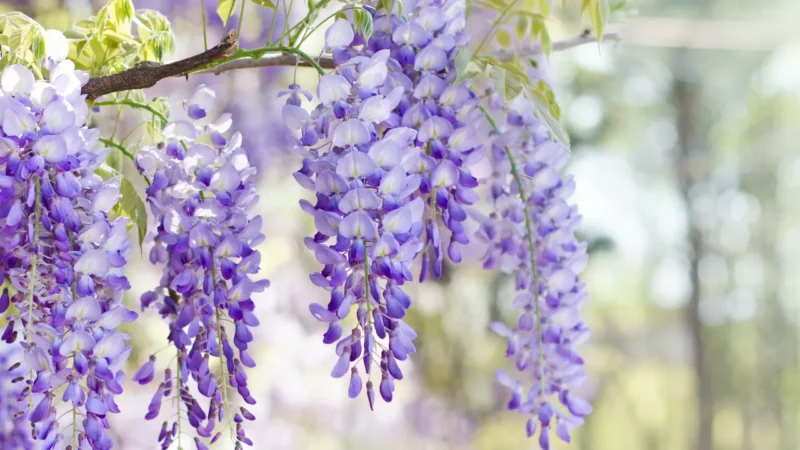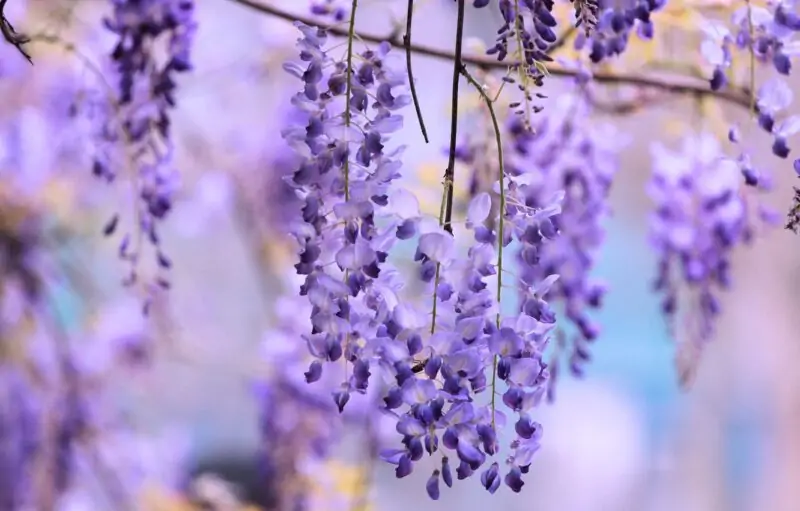The Ultimate Guide to Wisteria Plant: How to Grow and Care for Wisteria Vine

Ah, the wisteria plant, also known as Japanese beetles! A beautiful, flowering vine that has inspired gardeners, poets, and nature enthusiasts for centuries. This captivating climber, known for its cascading clusters of fragrant blooms, is y remarkable addition to any landscape. Today, we’re going to embark on a comprehensive journey, exploring the many fascinating facets of the wisteria vine. Wisteria can be grown by most people, so why not give it a try? From its various types to its cultivation and care, we have got it all covered.
Types of Wisteria Plant
Distinguishing Characteristics of Different Wisteria Types
Wisteria, celebrated worldwide for its stunning blooms and robust growth, comes in several species, each bearing distinctive traits that set them apart. Let’s start with the North American types, specifically the American Wisteria and the Kentucky Wisteria. These types are known for their smooth seed pods and vigorous growth. While they may not bear as many flowers as their Asian counterparts, their resilient nature and rapid growth make them uniquely appealing.
On the other hand, we have Asian varieties, including Chinese and Japanese Wisteria. These types are characterized by an abundance of bloom clusters and fuzzy seed pods. Asian wisterias are renowned for their beautiful, cascading flower clusters. Their stunning bloom display compensates for their aggressive growth, which requires regular maintenance to keep under control.
Most Popular Wisteria Types for Gardening
Among the several types of Wisteria, the Asian varieties, specifically Japanese and Chinese wisterias, are gardeners’ favorites. The plants may be aggressive growers, but their exquisite blooms, which grace gardens in full sun, are worth the extra effort. They take a few years to mature, but once they do, they can transform a pergola, arbor, or even a simple garden fence into a captivating, floral spectacle.
Getting to Know the Wisteria Vine
Structure and Lifespan of a Wisteria Vine
A wisteria vine is truly an impressive sight. Its structure, comprising twining stems and lengthy racemes of flowers, is distinctive and charming. Wisterias are also long-lived plants. Some wisteria vines, like the one planted in 1894, are still thriving today, bearing witness to the plant’s incredible lifespan.
Recognizing the Health and Growth Stages of a Wisteria Vine
The health and growth stages of a wisteria vine can be discerned by observing a few key indicators. A healthy wisteria vine will exhibit new growth in late spring or early summer. This is followed by the emergence of buds that burst open to reveal clusters of flowers. Wisteria flowers typically arrive about two weeks later, presenting a captivating sight that marks the height of the growing season.
How to Grow Wisteria
Choosing the Right Location for Your Wisteria
The location of your wisteria plant plays a vital role in its growth and blooming. Wisteria thrives best in a location with at least six hours of direct sunlight daily. Hence, keeping the plant near your house, on a pergola, arbor, or free-standing tree is advisable. While Wisteria can grow in partial shade, it blooms best in full sun.
Preparing the Soil for Planting Wisteria
Just as important as location is the type of soil you plant your Wisteria in. Ideally, a Wisteria requires well-drained soil, making locations with sandy, loamy, or clay soil suitable as long as good drainage is ensured. Before planting, consider enriching the soil with compost or other organic matter to promote healthy growth and maintain the appropriate moisture levels. Remember, a plant’s root ball that stays too wet can lead to the development of diseases, affecting the overall health of the wisteria vine.
Propagating Wisteria
Best Time and Method for Propagating Wisteria
For plant lovers, spreading Wisteria can become a rewarding task. It gives you more of these lovely vines without any extra cost. While it can be grown from seed, the easiest and most successful method is through softwood cuttings, ideally in early summer.
How to Successfully Grow a Propagated Wisteria
To propagate Wisteria, take a cutting of 18 inches from new growth on the plant. Plant the cutting in a pot filled with a well-draining mix. Remember to keep the pot in a warm spot that receives partial shade. With the right care, you’ll see the plant start to grow quite fast, and voila! You have successfully propagated a new wisteria vine.
Pruning Wisteria
Why and When to Prune Wisteria
Pruning plays a vital role in wisteria care. You need regular pruning to keep the plant’s aggressive growth in check, while also encouraging flower production. The best time to prune Wisteria is late winter when the plant is dormant, ensuring the plant’s energy is directed towards flowering, not unnecessary growth. Depending on your garden, you may find your plant requires less pruning.
Step-by-step Guide on How to Prune Wisteria
Pruning wisteria isn’t complicated. Here’s a simple guide: Start by identifying old wood, which typically won’t produce flowers. Next, cut the main vine back to three feet. This helps maintain size and promote branching. Then, trim the side shoots to about six inches. Remember to remove at least half of the prior year’s growth. This stimulates flowers on new growth and, in turn, more blooms.
Encouraging Wisteria to Bloom

Factors Influencing Wisteria Bloom
The wisteria plant has certain requirements for blooming. It needs full sun, nutrient-rich soil, and proper pruning. A lack of any of these factors can result in fewer or no blooms. Remember, wisteria blooms appear on new growth, so proper care is essential to make your wisteria vine bloom.
Tips and Tricks to Encourage Flowering in Wisteria
To encourage your Wisteria to bloom, give it ample sunlight – at least six hours of direct sun each day. Regular pruning is another trick to boost flowering. Remove at least half of the prior year’s growth to stimulate new growth. Remember, wisteria flowers bloom on new growth, so the more you promote it, the more blooms you’ll get!
FAQs
Wisteria can be a bit of a diva when it comes to blooming. If your plant isn’t flowering, it could be because it isn’t getting enough sun, it’s too nitrogen-rich, or it needs more pruning.
Give your Wisteria about an inch of water each week, increasing during hot, dry spells.
Prune your Wisteria in late winter when the plant is dormant, to direct its energy towards flowering.
Softwood cuttings are the easiest and most successful way to propagate Wisteria. Take an 18-inch cutting from new growth, plant it, and watch your new wisteria vine grow!
Conclusion
And there you have it, folks, a deep dive into the world of the wisteria plant! We’ve gone from understanding the different types of Wisteria, and how to grow and care for this stunning vine, to training, propagating, and even encouraging it to bloom. With this guide in your hands, you’re now more than ready to grow your own wistful Wisteria. Whether you opt for the North American Wisteria, the Chinese, Japanese, or the Kentucky one, you’re bound to enjoy its clusters of fragrant flowers and delightful twining habit.